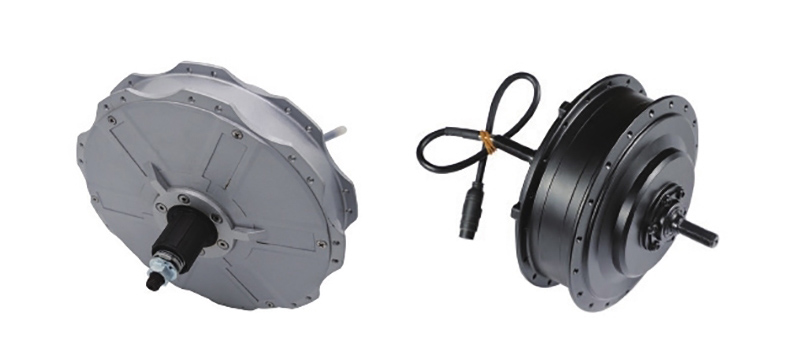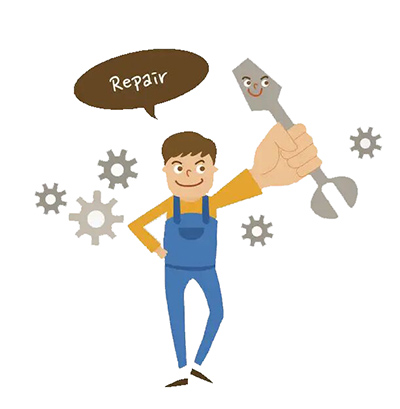In-wheel Hub Motor Basic Introduction
As the name implies, hub motors place the electric motor in the front or rear wheel hub to help you move the bicycle down the road. A mid-motor puts an electric motor and gears right on the pedal shaft and boosts your pedal power directly, transmitting it through a chain or belt to the rear wheel. There are two types of BLDC hub motors sold online by ATO: Gear hub motors and gearless hub motors. Next, we will introduce hub motor in detail.
What is hub motor?
In-wheel motors belong to the DC motor family. They do not have any commutator and brush mechanism to generate excitation in the windings. In in-wheel motors, the stator is a stationary part with an iron core and slots in which the copper windings are bonded. Most in-wheel motors use trapezoidal windings. The commutation of these windings is done by an external drive circuit. It supplies DC pulses to the stator windings so that it can magnetize each slot at a specific time. The inner periphery of the rotor has "n" magnets, or permanent magnets, arranged in alternating magnetic fields.

Working principle of in-wheel hub motor
The hub motor is the motor embedded in the wheel reel, the stator is fixed on the tire, the rotor is fixed on the axle, and the stator and rotor move relatively when the power is turned on. The electronic commutator (switch circuit) controls the energization sequence and time of the stator winding according to the position sensor signal, generates a rotating magnetic field, and drives the rotor to rotate.
Advantages of in-wheel motors
- A large number of transmission components are omitted to make the vehicle structure simpler.
- A variety of complex driving methods can be realized.
Because the in-wheel motor has the characteristics of independent driving of a single wheel, it can be implemented relatively easily whether it is front-wheel drive, rear-wheel drive or four-wheel drive. Full-time four-wheel drive is very easy to implement on vehicles driven by in-wheel motors.
Disadvantages of in-wheel motors
- Although the quality of the vehicle is greatly reduced, the unsprung quality is greatly improved, which will have a huge impact on the handling, comfort and suspension reliability of the vehicle.
- The cost issue, the high conversion efficiency, lightweight four-wheel hub motor cost remains high.
- Reliability problem. Putting the precision motor on the hub, long-term violent up and down vibration and the failure problem caused by the harsh working environment (water, dust), also consider that the hub part is the part that is easily damaged in a car accident. Maintenance costs are high.
- The problem of braking heat and energy consumption is that the motor itself is generating heat. Due to the increase in the unsprung mass, the braking pressure is greater and the heat generation is also greater. Such concentrated heat generation requires high braking performance.
How to repair the hub motor?
- Observe. Look at the degree of damage to the motor ring. It is definitely "reshaping" or replacement. If the motor ring is a steel ring or an iron ring and the impact deformation is not too serious, you can use a hammer to shape it to prevent the motor ring from deforming and causing a tire blowout. Round and bumpy, even if it will not be in place, it will not affect continued use. If the motor coil is made of aluminum, it is deformed, cracked or damaged, please replace it.

- Disassembly. When disassembling, it is best to spray and remove rust on the part to be disassembled with rust remover to facilitate disassembly. For example: at both ends of the motor shaft, connecting the brake screw, etc.
- Clean up. The motor end caps are mostly hexagonal screws. After a long time, there will be sludge and foreign matter at the edges, which will cause trouble for disassembly. It is more difficult to disassemble if the edges are forcibly removed. After the things are cleaned out, the hexagonal wire is easily unscrewed.
- Pier strike. The stator and rotor of the motor are attracted by the magnets, which are generally separated by piercing. When the pier strikes, try to be as parallel as possible. When the pier strike is about to be separated from the rotor, do not "buckle" the stator with your hands. If the force cannot be controlled, the stator will be sucked back into the rotor, and it is easy to pinch your hand and hurt it. Be sure to remove the other end cap as well.
- The magnetic steel separates the motor coil. Due to the brittleness of the magnetic steel inside the electric vehicle motor, NdFeB, Samarium Cobalt and AlNiCo magnets are generally used! It is best to use an aluminum tool for separation. First, "kick" one of the magnets. Since the magnet is divided into s-pole and n-pole, do not touch it wrongly, so as to prevent the magnetic field from being disturbed and cause the motor to work abnormally.
- Check the position of the magnetic steel sheet for pasting. Find a magnetic steel sheet to check whether the polarity of the paste is correct. An s-pole adjacent must be an n-pole. If the arrangement is wrong, please correct it! After confirming that it is correct, please use glue to stick it. The glue should use anaerobic glue 603 or 648 as much as possible, or 502, to ensure that each magnetic steel sheet is pasted and prevented from falling off.

